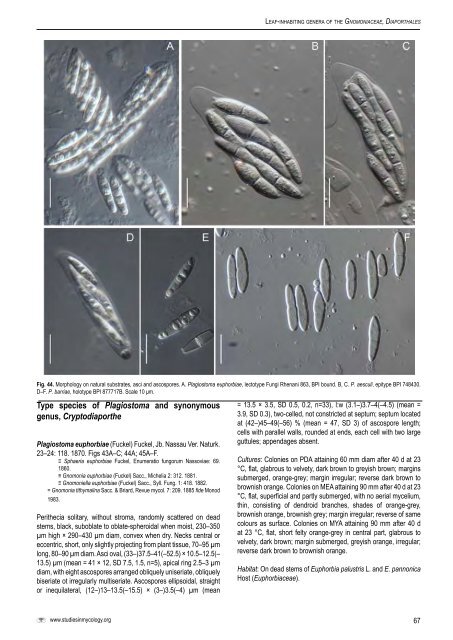Leaf-inhabiting genera of the Gnomoniaceae, Diaporthales - CBS
Leaf-inhabiting genera of the Gnomoniaceae, Diaporthales - CBS
Leaf-inhabiting genera of the Gnomoniaceae, Diaporthales - CBS
You also want an ePaper? Increase the reach of your titles
YUMPU automatically turns print PDFs into web optimized ePapers that Google loves.
Le a f-i n h a b i t i n g g e n e r a o f t h e Gn o m o n i a c e a e, Di a p o r t h a l e s<br />
Fig. 44. Morphology on natural substrates, asci and ascospores. A. Plagiostoma euphorbiae, lectotype Fungi Rhenani 863, BPI bound. B, C. P. aesculi, epitype BPI 748430.<br />
D–F. P. barriae, holotype BPI 877717B. Scale 10 μm.<br />
Type species <strong>of</strong> Plagiostoma and synonymous<br />
genus, Cryptodiapor<strong>the</strong><br />
Plagiostoma euphorbiae (Fuckel) Fuckel, Jb. Nassau Ver. Naturk.<br />
23–24: 118. 1870. Figs 43A–C; 44A; 45A–F.<br />
≡ Sphaeria euphorbiae Fuckel, Enumeratio fungorum Nassoviae: 69.<br />
1860.<br />
≡ Gnomonia euphorbiae (Fuckel) Sacc., Michelia 2: 312. 1881.<br />
≡ Gnomoniella euphorbiae (Fuckel) Sacc., Syll. Fung. 1: 418. 1882.<br />
= Gnomonia tithymalina Sacc. & Briard, Revue mycol. 7: 209. 1885 fide Monod<br />
1983.<br />
Peri<strong>the</strong>cia solitary, without stroma, randomly scattered on dead<br />
stems, black, suboblate to oblate-spheroidal when moist, 230–350<br />
µm high × 290–430 µm diam, convex when dry. Necks central or<br />
eccentric, short, only slightly projecting from plant tissue, 70–95 µm<br />
long, 80–90 µm diam. Asci oval, (33–)37.5–41(–52.5) × 10.5–12.5(–<br />
13.5) µm (mean = 41 × 12, SD 7.5, 1.5, n=5), apical ring 2.5–3 µm<br />
diam, with eight ascospores arranged obliquely uniseriate, obliquely<br />
biseriate ot irregularly multiseriate. Ascospores ellipsoidal, straight<br />
or inequilateral, (12–)13–13.5(–15.5) × (3–)3.5(–4) µm (mean<br />
= 13.5 × 3.5, SD 0.5, 0.2, n=33), l:w (3.1–)3.7–4(–4.5) (mean =<br />
3.9, SD 0.3), two-celled, not constricted at septum; septum located<br />
at (42–)45–49(–56) % (mean = 47, SD 3) <strong>of</strong> ascospore length;<br />
cells with parallel walls, rounded at ends, each cell with two large<br />
guttules; appendages absent.<br />
Cultures: Colonies on PDA attaining 60 mm diam after 40 d at 23<br />
°C, flat, glabrous to velvety, dark brown to greyish brown; margins<br />
submerged, orange-grey; margin irregular; reverse dark brown to<br />
brownish orange. Colonies on MEA attaining 90 mm after 40 d at 23<br />
°C, flat, superficial and partly submerged, with no aerial mycelium,<br />
thin, consisting <strong>of</strong> dendroid branches, shades <strong>of</strong> orange-grey,<br />
brownish orange, brownish grey; margin irregular; reverse <strong>of</strong> same<br />
colours as surface. Colonies on MYA attaining 90 mm after 40 d<br />
at 23 °C, flat, short felty orange-grey in central part, glabrous to<br />
velvety, dark brown; margin submerged, greyish orange, irregular;<br />
reverse dark brown to brownish orange.<br />
Habitat: On dead stems <strong>of</strong> Euphorbia palustris L. and E. pannonica<br />
Host (Euphorbiaceae).<br />
www.studiesinmycology.org<br />
67

















